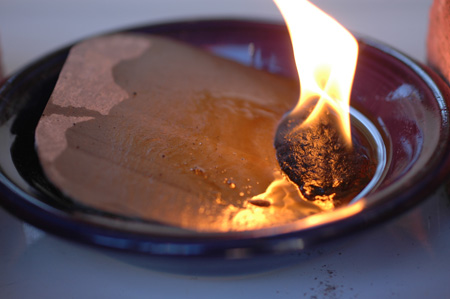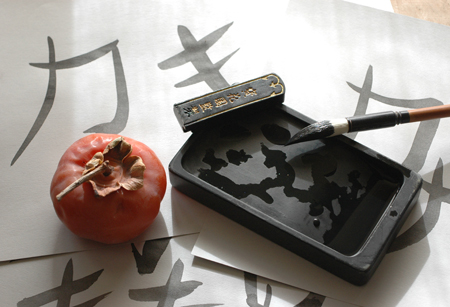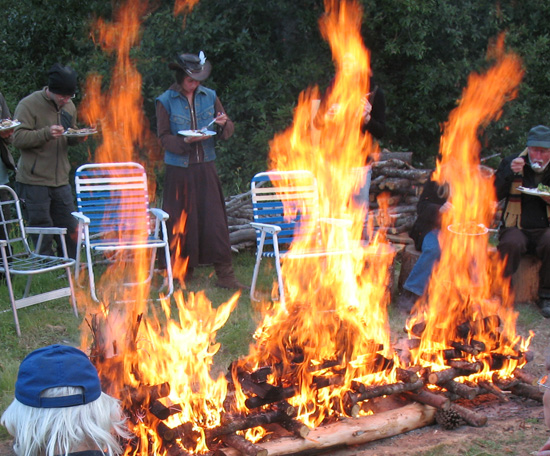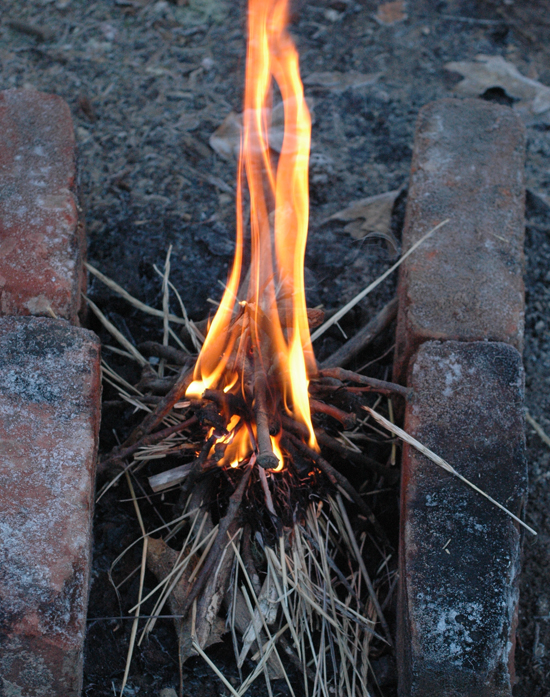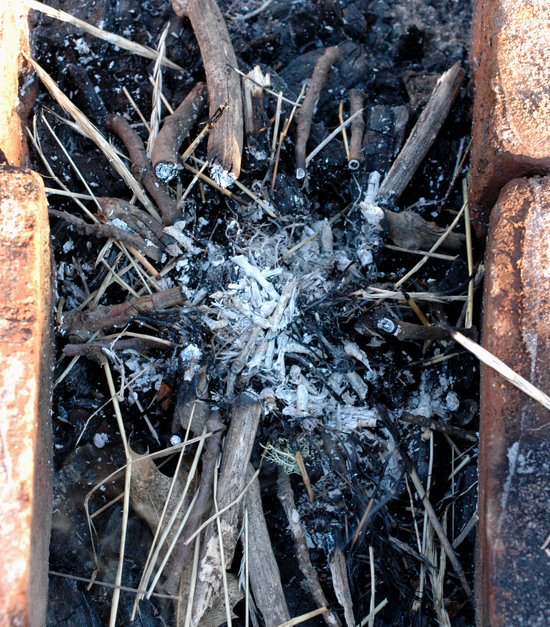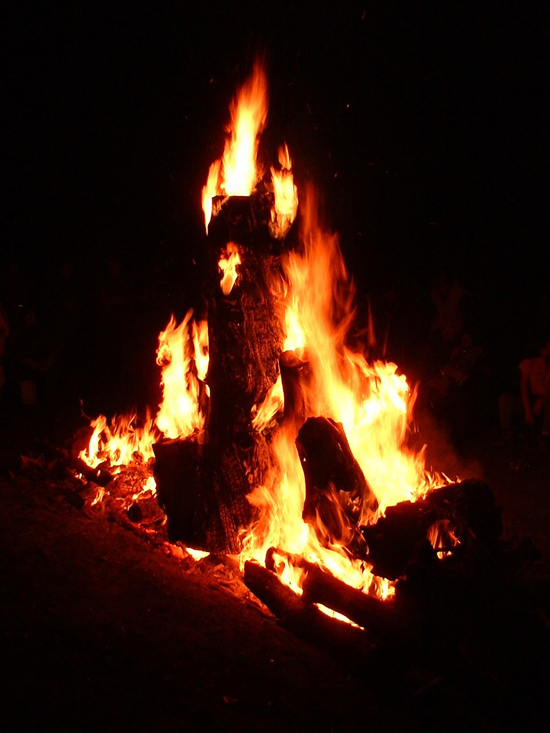A common mistake in design and assessment is to focus on one or two narrow parameters at the expense of everything else. For instance, elevating one factor so high in priority that outlandish expense is gone to in order to achieve it without considering cost/benefit ratio. No doubt in some cases prioritizing something that highly is the correct thing to do, but a common trap is to fail to consider design or assessment of a system in context. As I was finishing up writing this blog post, I received this comment on my video about burning brush in open piles to make biochar.
“Looks more like a video on how not to do it. Cone pits or trenches are much more efficient and produce far less ash. Even a proper 55 gallon oil drum burn does better in my experience, although thats more for scrap pallet wood. ”
This comment seems to highlight the mistake of putting a single parameter, in this case conversion efficiency, above all other considerations, and in their context presumably and not mine, which they clearly don't understand. You can read my reply to that comment on youtube, or watch this follow up video about considering context in comparing charring methods, which that commenter obviously missed (I hope lol) but everything important I have to say about it is also in this rather lengthy article; the purpose of which is to elaborate on why I use open burn methods and possibly more importantly, to simply discuss the importance of context, resources and cost/benefit when defining priorities and making decisions.
CONTEXT IS KING
Using simple methods of production, I have been able to accumulate hundreds of gallons of char and should have hundreds more by the end of the burn season. The intimidation or time and materials required in the building of a retort or TLUD burner, or even a stand alone cone kiln, hold many people back from getting started with biochar. Building those can be intimidating or otherwise hard to pull off. There are also claims about charcoal quality from the various systems, which may have people holding out to produce "real" biochar and not just charcoal. But, there doesn't seem to be any consensus on that, and there is plenty of evidence that just about any charcoal is effective to a degree, whether it is hard or soft, burned hot, or burned cool. That is not to say that some types are not more effective, or that such has not already been proven. I'm not really up on the latest, or up on that discussion at all really. While some systems are undoubtedly more conversion efficient than others, there are other considerations and many of the possible draw backs of open burns are basically eclipsed by the great ease, minimal processing and speed of open burn systems.
A TLUD system, for instance, requires chips or other small, somewhat homogenous fuel sizes, which is only great if you have easy access to that kind of fuelstock. If you have easy access to an industrial strength chipper, maybe that makes it a viable option as well, but to purchase and own such a thing is a great expense and would not make sense for most people. I'm pretty sure it would have a higher conversion efficiency than the trench or pile approaches I use, that is higher charcoal produced for the amount of wood put in, but that has to be weighed against having to chip the stuff. This is what I'm talking about with the focus on one aspect. Conversion efficiency, i.e. WOOD/CHARCOAL ratio, has to be weighed against many other factors in order to make a rational decision.
One of those factors is labor and the input of other resources. Even with the large amount of wood my land produces (and the neighbors' land if I were to expand operations), I couldn't justify buying, or even renting a chipper until I hit an economy-of-scale tipping point. So, lets say I hit that point and rent a chipper for 700.00 for a week or whatever it costs. Then I have to have metal TLUD kilns to burn it in. On that scale I'd be burning through 55 gallon drums pretty fast and probably burning 4 to 6 of them at a time to produce 100 gallons of charcoal in a run. Contrast that against open piles which require a shovel and a hose, no fuel, no cost and less handling and transportation in many cases, and the TLUD starts to lose points, even if there is a significant conversion loss to ash in the open burns. Lets say that loss is as high as 20%, which i really have no idea. But say it is. I still have to think hard about adopting that expensive system, especially if I start thinking about building larger, more robust burners that will produce 100 gallons in a single run and not burn out quickly. I could go on, but it's energy, financial expense and time v.s. conversion efficiency. And the truth is that I still don't know how efficient or inefficient the open burns are. My impression from the beginning is that they are actually surprisingly efficient, but there is an obvious loss to ash, and probably considerably more in the open piles than the open trenches.
Retort systems use some quantity of wood to heat an inner chamber of charcoal. A simple retort would be a drum full of wood that is sealed off except for a pipe coming out the top, which terminates under the barrel. If you build a fire under that barrel, it heats the wood inside, releasing gasses in the sealed drum that travel through the pipe and back into the fire underneath. The gasses are flammable (wood-gas), so the wood in the drum helps burn itself as the gasses are flared off underneath. That's one of the first ways I learned to make charcoal for smithing many years ago. One obvious consideration for a retort is that the system requires fuel to be consumed to make the charcoal, which is an inherent inefficiency. That inefficiency can be reduced to an extent by design and should probably always be more refined than a simple drum with a fire underneath it, but the consumption of fuel is inherent to the method and has to be considered in a fair assessment.
In comparing retorts to open burns, there are a couple of possible advantages to retorts. One would be that it produces a harder charcoal, which some people claim is better. I just don't know if that is true or not and I've seen the opposite claim as well. Certainly, if you are producing charcoal for industrial use, heating or cooking, you want a hard, dense, long burning charcoal produced in a low oxygen environment. Another possible advantage to retorts would be that since the wood that is being charred is mostly sealed up, with just small holes in the container for the gasses to escape as it's heated, it can't really over burn. So, if you had the system dialed, hopefully you could load it, fire it off, walk away and come back to finished extinguished charcoal.
If the charcoal from a retort really is more effective as a soil amendment, then a careful comparison would have to take that into account as a possible counterbalance to the fuel consumed in it’s own production, especially when comparing to an open burn which also has some inherent loss to ash, no matter how well it is run.
A clear disadvantage to a retort is that dry fuel is going to be much better performing. It rained yesterday, but I could still go out and mix my dead and green material together and fire it off, or burn a trench and not only get away with burning my now damp wood, but burning some green stuff with it as well. I do not have storage or drying facilities for the large quantities of wood I’m dealing with to burn dry wood in a retort or TLUD. To burn dry wood I would either have to build a large dedicated shed area also requiring that I handle the wood more, or a large vegetation free area, probably even a screened room, to be able to burn in the summer when it’s very dry.
There is a lot of information I don’t have and a lot of information out there that I have not availed myself of. But in a big picture context, I’m not focused on any single factor and my personal context drives my choices. What I know is that I can produce very large quantities of charcoal with NO MONEY INPUT AT ALL, or building or rebuilding anything, just a shovel and a hose, and in the case of open piles I don’t even need the shovel. I can do that with minimal processing of the fuel and no careful storage. It is fast and requires almost no size reduction of the stock, though I prefer to burn trimmed poles and limbs for ease of handling, storage and they function much better in the pit that twiggy stuff does. I trim out the larger, easier limbs for the pit and burn the really brushy stuff in piles, though there is overlap in this spectrum for sure, I find the two methods VERY complementary to each other. They are simple and low input, and with the quantities of wood I have to deal with, I would probably get less wood actually burned in a small retort or TLUD system, while scaling up to a large TLUD or retort would probably get expensive.
Again, there is information I don’t have here and I’m not suggesting my way is better, just that it seems better in my context, especially since I can get it done. Even if someone was able to prove to me that retort produced char is twice as effective, I would still have to consider whether I could pull off charring the quantities of wood I have available, or consider just letting half of it rot and charring less, while also weighing in the added financial outlay and work of setting the system up, as well as the drying and storage of wood. And lets examine that effectiveness of different char types thing next, because that gets interesting.
My positive results using biochar have not been uniformly phenomenal, but they have been almost uniformly obvious. The most phenomenal was my leek bed this year with what I estimated to be 400% to 600% higher productivity at 10% char, all of it open burned or scrounged up from firepits and woodstoves. That is 4 to 6 times the production all other things being equal, so the char is effective. The question at this point is just about quantities and level of effectiveness of different chars, rather than if they are effective at all. If retort char were more effective, it would have to be quite a bit more effective to start tilting me in it’s direction when looking at the other considerations I’ve already brought up. BUT, check this out.
I used 33% in one test bed, and 25% in another., both two feet deep. Both of those sections also have 50% char in the top 4 to 6 inches of the bed! Is that crazy? Well, I can tell you it takes a crazy amount of charcoal! But damn are those beds nice. Only long term observation will convince me if they work better or worse than beds with less, or even more char, but there is an obvious advantage in weeding, soil crusting and therefore maintenance.
I’ve been gardening here and elsewhere for a long time, and one of the great problems of gardening is soil crusting. Why it isn’t discussed more I have no worldly clue. No soil I've ever worked with is completely immune to it and most are very susceptible. If you disturb soil and water it, the problem of soil crusting manifests it’s flat and ugly visage. It impedes water penetration, but causes more rapid evaporation. Water a crusty bed and a lot of the water can run off instead of soaking in, and then you’ll lose the water that does make it into the soil more quickly unless you cultivate to create a “dust mulch” as soon as you can, or cover the whole soil surface with something. In those two test beds with 50% char in the top 6 inches, soil crusting is no longer an issue, period. The soil is very loose, which makes weeding easy. Water penetrates, period. No matter what the history of the bed, weather, vegetation cover etc and so on, water penetrates every time. EVERY TIME I WATER! Chunks of charcoal migrate to the top of the bed and cover at least 50% of the surface as a mulch. Don’t forget, that is a MULCH THAT DOESN’T EVER ROT! I can add surface amendments for nutrition, like compost or coffee grounds, but gone is the need to either cultivate or cover the soil surface with mulch after watering. GOOOONE!!! Wow, I freaking love those beds. Though they are just two small sections of two small beds, I have a sinking, unhappy, I’m-wasting-my-time feeling when I have to plant in any other beds. Just today I was out planting tomatoes in my 10% and 5% char beds and it was fairly lumpy, crusted over and generally unpleasant to work with. I’m going on a tangent, but I have a point in the context of this article, which is that at application levels of 25% to 50%, the quality of the char may become somewhat irrelevant if the goal is as much about high charcoal content for physical effects as it is about the reasons that biochar is probably more usually applied for, like nutrient holding.
To tie this up, my guess is that a majority of people reading this will be best off at least just starting with open burn methods, unless you have access to chips, in which case you might consider building a TLUD. At the very least it gets you off the ground and running immediately. There will be more wood to char later. It is fast and you can do it all over your property or even on other people’s properties, rather than always transporting all of your wood to a single location or transporting burners. I’ve already heard from a number of people that they busted a move with the trenches or open burn piles and are now producing char instead of ashes, or instead of accumulating wood waiting for the day when they get some device together that they thought they needed. David the Good's recent comment was "Open burns really are the way to go. I thought about biochar for a long time and looked at all kinds of systems that I really didn't feel like building... then started making big fires and spraying them with the hose. Now I have lots of char."
I’ve said it over and over again, the primary problem of biochar that needs solving for the masses is accessibility. The idea that you have to make the proper kind of char, the proper way, or that there is a material difference between “biochar” and charcoal in every context is unsupportable. The best biochar is the biochar you get made and buried in the ground, just like the best camera is the one you have with you. We can always view things in ideals like super high production, beauty, convenience and so on, but that view approach minimizes the importance of context. If anyone interprets this article as being negative against, or disregarding other methods of biochar production, you aren’t reading carefully enough. I could definitely see adopting other methods than open burns in the future, but only when and where they make sense. I am just as much not trying to sell you in particular on open burns v.s. other methods. I’m just imploring everyone to think in context and consider, costs, benefits and resources in making these decisions.
We can apply this type of thinking to life, problem solving and decisions in general, and we should. We may not always have all of the information, or the best information, or be able to foresee everything that we need to foresee to make the perfect decision, but that is not what problem solving is about. Good problem solving, design and understanding are a journey not a destination. For all I know someone will read this article, drop some new knowledge or information on me that affects my thinking and ultimately changes the way that I produce biochar. That would be great. Better is better and that’s where I’m always trying to head. But that also doesn’t mean that I’m going to put large amounts of resources into research and experimentation to refine the process and my approach to it to within a gnats ass of perfect efficiency, because the time and energy and thought space to do so is also part of my context and my personal cost v.s. benefit equation. So, at this point, I’m fairly content to just hang here with what I’m doing and refine it in small ways as I can until I have some reason to stretch out in other directions, or someone wanders along and drops some game changing knowledge on me.
AVAILABLE RESOURCES
COST BENEFIT ANALYSIS
CONTEXT





